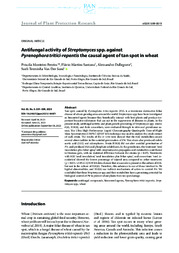Antifungal activity of Streptomyces spp. against Pyrenophora tritici-repentis the causal agent of tan spot in wheat.
Antifungal activity of Streptomyces spp. against Pyrenophora tritici-repentis the causal agent of tan spot in wheat.
Autoria: PEREIRA, P.; SANTANA, F. M.; DALLEGRAVE, A.; VAN DER SAND, S. T.
Resumo: Tan spot, caused by Pyrenophora tritici-repentis (Ptr), is a worrisome destructive foliar disease of wheat-growing areas around the world. Streptomyces spp. have been investigated as biocontrol agents because they beneficially interact with host plants and produce important bioactive substances that can act in the suppression of diseases in plants. In the present study, antifungal activity and plant growth-promoting of Streptomyces spp. strains 6(4), R18(6), and their consortium, were evaluated through in vitro and greenhouse assays. The Ultra High-Performance Liquid Chromatography-Quadrupole Time-of-Flight Mass Spectrometry (UHPLC-QTOF MS) technique was used to analyze the crude extract of each strain. The results of the in vitro tests showed that the 6(4) metabolites caused several abnormalities in the conidial germination of Ptr. This strain also produced indole acetic acid (IAA) and siderophores. Strain R18(6) did not alter conidial germination of Ptr, and produced IAA and phosphate solubilizers. In the greenhouse, the treatment ‘seed inoculation plus foliar spray’ with streptomycetes propagules and metabolites contributed to biomass gain, with no statistical difference between the strains (p < 0.05). Treatments with 6(4) ‘seed inoculation’, ‘seed inoculation plus foliar spray’, and consortium ‘seed inoculation’ showed the lowest percentage of injured area compared to other treatments (p < 0.05). UHPLC-QTOF MS data showed that erucamide is present in the culture of 6(4), but not in the culture of R18(6). Therefore, this substance is one of those involved in Ptrhyphal abnormalities, and R18(6) use indirect mechanisms of action to control Ptr. We concluded that these Streptomyces spp. and their metabolites have a promising potential for biological control of Ptr to protect wheat plants from tan spot damage.
Ano de publicação: 2023
Tipo de publicação: Artigo de periódico
Unidade: Embrapa Clima Temperado
Palavras-chave: Doença, Doença Fúngica, Mancha bronzeada, Pyrenophora tritici-repentis, Trigo, Wheat
Observações
1 - Por padrão são exibidas publicações dos últimos 20 anos. Para encontrar publicações mais antigas, configure o filtro ano de publicação, colocando o ano a partir do qual você deseja encontrar publicações. O filtro está na coluna da esquerda na busca acima.
2 - Para ler algumas publicações da Embrapa (apenas as que estão em formato ePub), é necessário ter, no celular ou computador, um desses softwares gratuitos. Sistemas Android: Google Play Livros; IOS: iBooks; Windows e Linux: software Calibre.
Acesse outras publicações
Acesse a Base de Dados da Pesquisa Agropecuária (BDPA) para consultar o acervo completo das bibliotecas da Embrapa.

